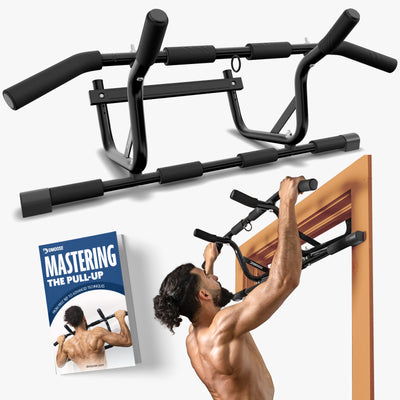You’ve got your Pull Up Bar for Doorway set up, and you’re ready to crush those reps, right? But before you dive in, let’s pause for a moment.
Did you know most people make simple, yet crucial mistakes that could slow down their progress or even lead to injury?
From unstable setups to improper form, these slip-ups are easy to overlook until they become a problem.
In this blog, we’re revealing the top 5 mistakes that could be holding you back and showing you how to fix them, so you can make every pull-up count.
5 Mistakes to Avoid for Better Results with Your Doorway Pull-Up Bar
In this section, we’ll cover the top 5 mistakes people make when using a pull-up bar, along with tips on how to avoid them, so you can make the most out of every workout.
1. Installing the Pull-Up Bar Improperly

Improper installation of a doorway pull-up bar is one of the most common mistakes and can be dangerous. An uneven bar or a weak doorframe causes instability that may lead to accidents or injury.
When the bar isn't securely mounted, it may shift or wobble during use, increasing the risk of falls or strains. Ensuring proper installation is essential for both safety and performance.
Solution
To prevent installation mistakes, follow these tips for a secure setup:
- Check the doorframe’s strength: Ensure the frame is sturdy enough to handle your weight. A wooden frame with solid studs is ideal.
- Ensure proper alignment: Measure and make sure the bar is level before tightening the screws. A crooked bar can cause uneven resistance.
- Test the bar: After installation, apply pressure and test it with a few gentle pulls before starting your workout.
- Avoid over-tightening: Tighten the screws firmly, but don't overdo it, as this could damage the frame.
By ensuring your pull-up bar is installed securely, you’ll reduce the risk of instability and ensure a safer, more effective workout.
2. Focusing on Quantity Over Quality
A common mistake is focusing on the number of pull-ups or reps rather than on the quality of each movement. Rushing through exercises to hit a higher rep count can lead to poor form and unnecessary strain on muscles and joints.
When you prioritize quantity over quality, you’re not engaging the target muscles as effectively, which means you won’t see the results you’re aiming for. Additionally, doing too many reps with improper form increases the risk of injury.
Solution
To maximize the effectiveness of your pull-up bar workouts focus on the quality of each rep:
- Control your movements: Perform each pull-up with slow, controlled motion. Focus on using the right muscles rather than jerking your body upward.
- Perfect your form: Engage your core and keep your body aligned. Avoid swinging or using momentum, which reduces the effectiveness of the exercise.
- Prioritize proper technique: A few pull-ups with perfect form will yield better results than doing many with sloppy technique.
- Set manageable rep goals: Instead of aiming for an arbitrary number of pull-ups, set a realistic goal with a focus on form, such as 3 sets of 5 reps with full control.
By focusing on quality over quantity, you’ll not only minimize the risk of injury but also maximize your muscle engagement and strength gains.

3. Neglecting Warm-Ups and Mobility Work
One of the most overlooked aspects of a successful pull-up routine is warming up. Jumping straight into bodyweight exercises like pull-ups without preparing your body can lead to strain, tightness, or injury. Pull-ups require significant shoulder, arm, and wrist mobility.
Without adequate preparation, these areas can become stiff, increasing the likelihood of discomfort or injury during your workout. Especially if you’re working on increasing pull-up volume or intensity, neglecting mobility exercises before your workout is a mistake that can hinder progress.
Solution
A proper warm-up increases blood flow, improves joint mobility, and primes your muscles for the workout ahead. Here’s a simple routine to follow before starting pull-up sets:
- Shoulder Circles: Perform large, controlled circles in both directions for 30 seconds each to loosen up the shoulders.
- Arm Swings: Swing your arms back and forth to stretch and warm up the chest, arms, and shoulders.
- Wrist Flexor and Extensor Stretches: Gently stretch your wrists by pulling back on your fingers with the opposite hand, focusing on flexibility and preventing strain.
- Scapular Push-Ups: Place your hands on the ground and practice scapular retraction and protraction to activate the upper back muscles. Do 2-3 sets of 10 reps.
Taking 5-10 minutes to warm up before starting your pull-ups will prevent unnecessary strain and prepare your muscles for better performance. Engaging your core properly also makes a big difference in performance and injury prevention.
4. Not Engaging the Core and Stabilizers
Many people focus only on their arms and back during pull-ups, neglecting to engage the core and stabilizer muscles. This reduces the exercise’s effectiveness and puts additional strain on your shoulders and lower back.
The core is essential for stabilizing your body, preventing swinging, and ensuring full-body activation. Without engaging these muscles, you risk poor posture, less efficient workouts, and a higher chance of injury.
Solution
Maximize your pull-ups by focusing on core and stabilizer engagement:
- Tighten your core: Pull your belly button toward your spine to engage your abs and stabilize your torso. Learn more about core engagement.
- Maintain proper alignment: Keep your body straight throughout the movement, avoiding excessive arching or swinging legs.
- Activate your glutes: Squeeze your glutes at the top of each pull-up to maintain full-body tension.
- Control the descent: Lower yourself slowly while keeping your core tight to prevent swinging and maintain stability.
Engaging your core and stabilizers not only helps prevent injury but also makes each pull-up more effective by activating all relevant muscle groups.
5. Overusing the Pull-Up Bar or Doing the Same Routine
Pull-ups are excellent for upper body strength, but overusing the pull-up bar or repeating the same routine too often can cause muscle imbalances and burnout. Muscles need time to recover and adapt for optimal growth.
Without variety, some muscles may become overworked while others lag behind, leading to imbalances that stall progress and increase injury risk. Mental fatigue from repetitive routines can also reduce motivation and performance.
Solution
Introduce variety into your training to prevent burnout and imbalances:
- Alternate exercises: Add push-ups, dips, rows, and other movements to build balanced strength across all muscle groups. Check these upper body exercises.
- Use assisted pull-ups: Incorporate resistance bands or machines to reduce strain and allow for more reps.
- Add resistance bands: Use bands for varied resistance, challenging muscles in new ways.
- Mix in other bodyweight exercises: Switch to chin-ups, lat pulldowns, or inverted rows to target muscles differently.
Diversifying your routine keeps muscles engaged, helps break plateaus, and maintains fresh motivation for continued progress.
FAQs
1. Why does my pull-up bar feel unstable?
Improper installation or a weak doorframe may cause instability. Ensure your pull-up bar is securely mounted on a solid, level doorframe, and double-check the alignment to prevent wobbling.
2. Why am I not seeing progress in my pull-ups?
Sticking to the same routine can lead to plateaus. Incorporate variations like assisted pull-ups or resistance bands, and focus on proper form and increasing reps gradually to challenge your muscles.
3. Am I doing pull-ups incorrectly if I’m not using my full range of motion?
Yes, not extending your arms fully or pulling your chin over the bar reduces effectiveness. Make sure to use a full range of motion by fully extending your arms and pulling your chin above the bar with each rep.
4. Why is my pull-up bar damaging my doorframe?
Neglecting padding on your pull-up bar can lead to scuffs or damage. Ensure the bar has rubber padding on the contact points, or add extra cushioning to protect your doorframe from wear and tear.
5. How do I stop swinging during pull-ups?
Swinging is often caused by not engaging the core. Keep your body straight, tighten your abs, and focus on controlled movements to avoid relying on momentum during the exercise.
Conclusion
Now that you know the most common mistakes and how to avoid them, it’s time to put these tips into action.
By ensuring your pull-up bar is properly installed, focusing on form, and using it strategically, you’ll set yourself up for safer, more effective workouts. Remember, small adjustments can lead to big gains.
Keep challenging yourself, stay mindful of your technique, and watch your strength improve with every rep. The perfect pull-up is within reach. Just make sure you're not making these avoidable mistakes along the way!











